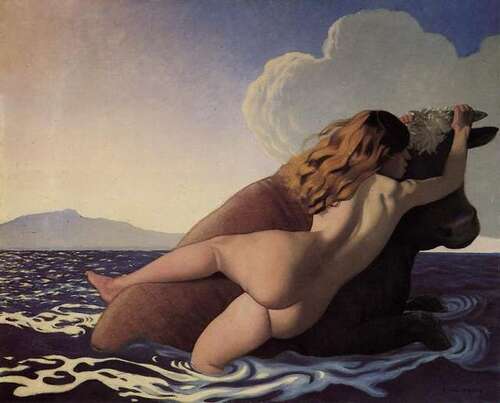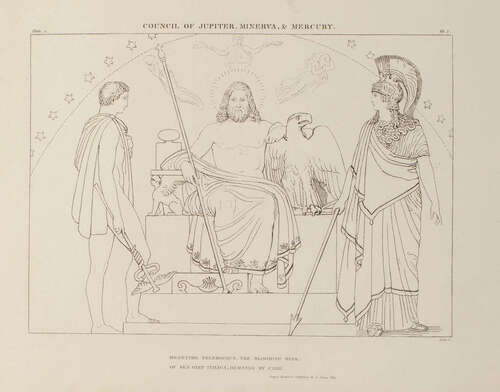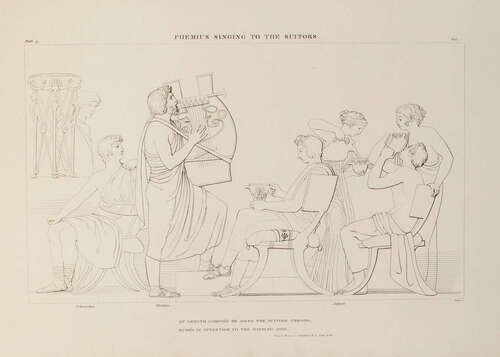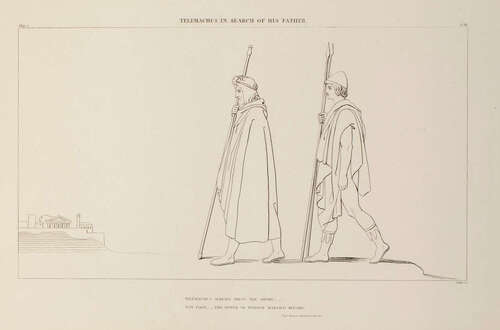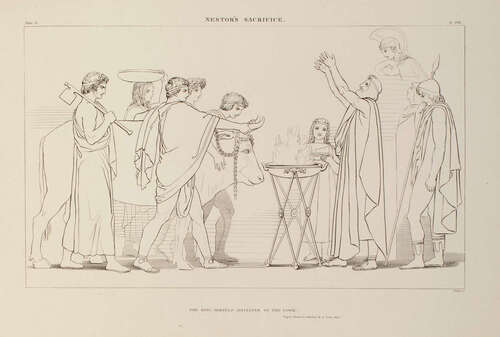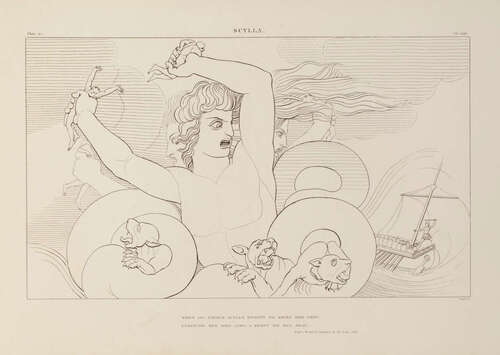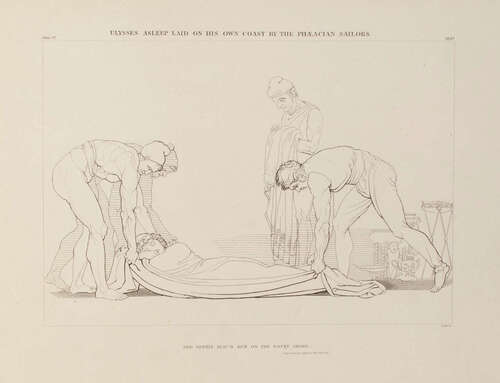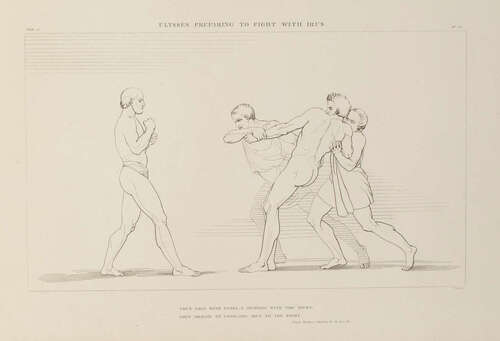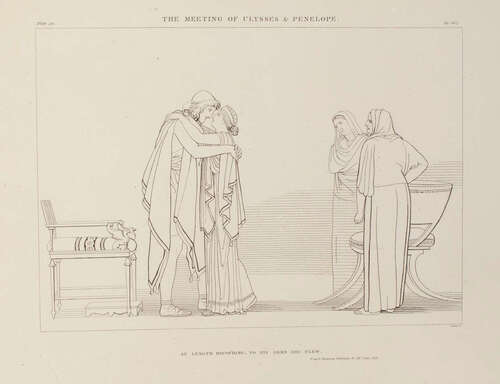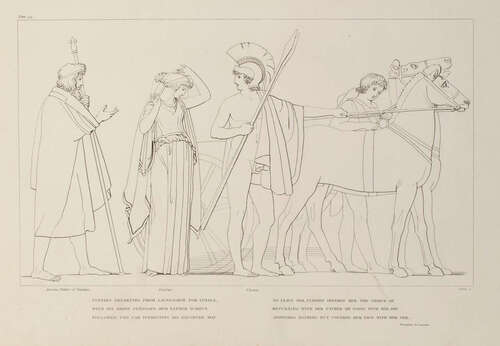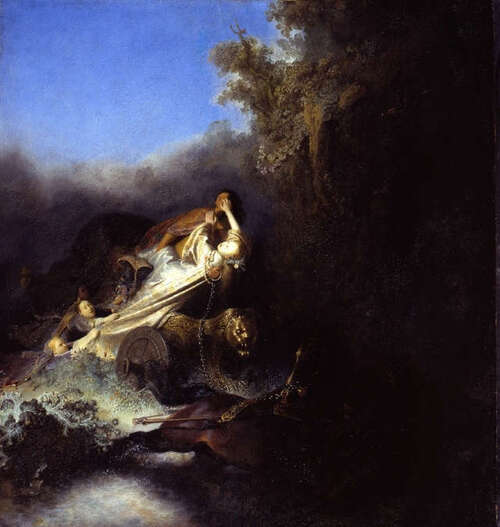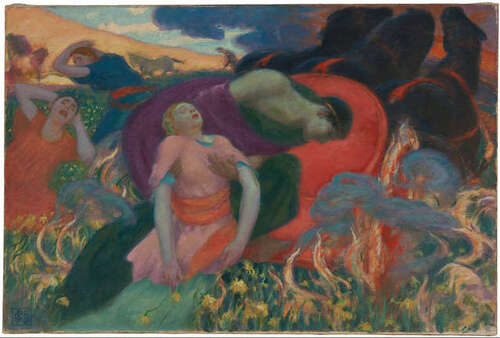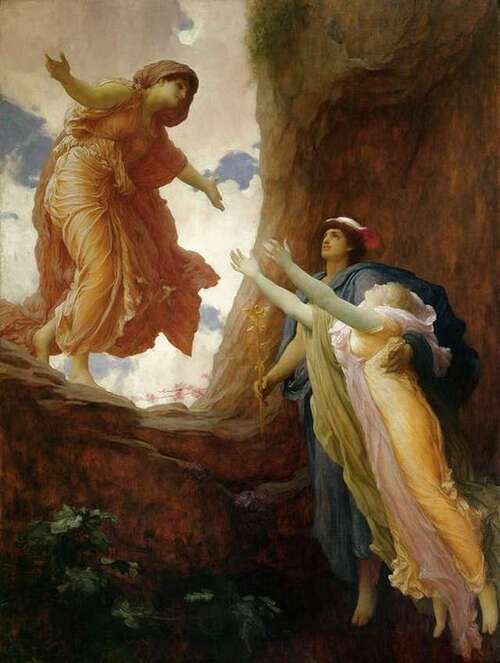-
Par mythos le 12 Août 2024 à 00:12
Felix Edouard Vallotton created several paintings inspired by Greek mythology. His approach was specific, with large areas of clear colors and strong edges. These paintings are just a drop in his large opus, yet interesting for every scholar or art lover. We'll present them in alphabetical order with a short summary of every presented mythological scene.
Andromeda
Andromeda is an Aethipean princess, the daughter of King Cepheus and Queen Casiopea. Casiopea once claimed that she and Andromeda were prettier than Nereids, daughters of Poseidon. Poseidon, of course, is a mighty god who is easily offended. He sends a sea monster Cetus to destroy Aethiopia as a divine punishment. There is only one option to prevent the devastation of Aethiopia - Andromeda has to be sacrificed. She is exposed on the rock, waiting for inevitable death, when Perseus, a Greek hero spots her. He is willing to fight the Cetus if Andromeda's parents promise him the beautiful princess for his wife. Arrangements are made and the fight begins. Perseus wins with the help of Medusa's head (he slain Medusa in one of his previous adventures), with the capability to petrify everybody who looks at it.
Felix Vallotton obviously loved the scene of Andromeda in trouble. He painted the image above in 1907. Note how he used different colors for each of the protagonists.
The fight between Perseus and Cetus was created in 1910. The lady in distress and the hero who has to kill the monster inspired thousands of similar scenes in art, including St. George, who also had to slay the dragon.
In 1918, Andromeda is still waiting for the rescuer. Her pink complexion is in striking contrast with a green background. Vallotton loved to confront complementary colors.
Seven years later, Andromeda is not tight up but chained. She seems desperate.
Crepuscule
Crepuscule is a rarely used word that means twilight, dusk, or partial darkness. It's of Latin origin and is mostly used by poets. In mythology, it has a very specific meaning, though. By crepuscule, the Sunshine of the Olympics is described. It's divine light, fire brought by Prometheus to humankind. It's a gift but also a curse. For Prometheus and humans.
Felix Vallotton painted Crepuscule in 1904. He perfectly caught the contrast between light and darkness, together with caused panic.
Europa
Europa is Phoenician princess. Her beauty attracts Zeus, who turns himself into a tame white bull. Europa starts playing with him and eventually gets on his back. Zeus uses the opportunity and swims with her to the island of Crete. Europa becomes the first queen of Crete and mother of Minos.
The abduction of Europa partly resembles the story of Persephone, abducted by Hades.
Orpheus
Orpheus is a musician and prophet. He has a wife Eurydice who dies, but Orpheus gets a chance to rescue her. He fails and mourns so long that maenads, female followers of Dionysus, can't stand it anymore and kill him. Problem solved.
Felix Vallotton painted the Orpheus' death in 1904. He used the opportunity to present maenads as cruel as possible, again with complementary colors of red and green in strong contrast.
Pentheus
Pentheus is a less-known character from the Greek mythology. He is partly of divine origin. His grandmother is Harmonia, goddess of concord and harmony. He is also a cousin of Dionysus, the god of theatre, rituals, wine, etc. When Cadmus, king of Thebes, abdicates, he gives the throne to Pentheus, his grandson. Pentheus soon forbids the worship of Dionysus, who in turn causes a so-called Bacchic frenzy resulting in running all the women of Thebe to Mount Cithaeron. Pentheus tries to imprison Dionysus, but chains fall off his body.
Pentheus tries to spy on Bacchic rituals by hiding in the tree. He is spotted there by his mother and aunts, taken down and torn apart.
Felix Vallotton portrayed the scene of his attempt to escape in a composition similar to Crepuscule and Orpheus (both made in the same year).
As we can see, colors play a crucial role in Vallotton's work. They were so important, that he often put them in the titles of his paintings, as well. Here is a selection of such paintings by Felix Vallotton. Share the stories with your friends!
 votre commentaire
votre commentaire
-
Par mythos le 17 Février 2024 à 02:16
Legend of Rudabeh
Rudabah or Rudaba was a princess in Persian mythology. To understand the story of Rudaba which is inextricably intertwined with Zal we need to start before her birth.
Zal (sometimes written as Zaal) was a son of Sam who was a great Persian hero. Sam was the son of another hero of Persia. His name was Nariman and he was also a son of a hero named Garshasp. And he was ... you probably get the picture, right?
Zal was born with white hair ('Zal' can be roughly translated as 'albino'). This was considered a bad omen and his father Sam blamed an evil spirit Ahriman for that. Zal was abandoned as a kid in Alborz Mountain. A mythological bird Simurgh, a bit similar to more known phenix from other mythologies adopted him and raised him in his nest.

Years later, a passing caravan spotted a young man in the nest. His white hair and silver mountain on his chest made a remarkable presence so the rumors about him spread fast and reached Sam. Sam talked to his counselors who advised him to check on his son. Sam had found the nest but couldn't reach it. So he prayed to the gods and asked for forgiveness. He wanted his son back.
Then Simurgh came and helped the father and the son to join again. When parting, Simurgh gave a feather to Zal and told him to burn it if he got into great trouble. The bird would know for his call and come to the rescue.
Zal spent some time in the court of his father and when Sam went to war started running the kingdom. Then he heard the song about Rudabeh. Rudabeh was the daughter of another king. He was Mehrab Kaboli.

The name 'Rudabeh' could be translated as 'the child of light'. Songs were praising her beauty, mentioning her silvern shoulders and long black hair. It compared her eyes to narcissus, the blackness of her eyelashes to raven's feathers, and her breasts to pomegranates. Zal fell in love without ever meeting her. The song was so persuasive.
He came to the Rudabah's palace and started inquiring about her. She heard about him as well and started getting information on her own. Her ladies-in-waiting were of great help. They arranged that young ones could meet.
The wall was tall but Rudabah's braids were so long she left them down so Zal could climb up. He didn't want to injure her and used a rope he brought with him. They talked for a very long time. Well, apparently they didn't just talk because she became pregnant.
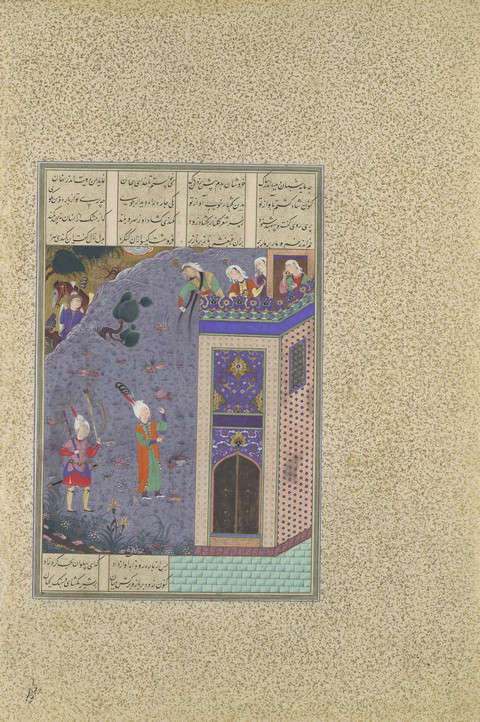
Rudabah's father didn't approve of the marriage and Zal's father was hesitant at the idea too. He knew Rudabeh was a descendant of evil serpent King Zahhak who had human brain-eating serpents on his shoulders. Zal told his father about his promise of fulfilling all of Zal's wishes. The court astrologers advised Sam to bless the marriage because the son of Zal and Rudabeh would be a great hero, a conquerer of the world. Mehrab Kaboli still didn't want to hear about the marriage and turned to the Emperor who demanded that Zal shows his skills.
Zal defeated all his best warriors, solved the hardest puzzles, and proved to be worthy of Rudabah's hand. Young ones could finally marry each other. The wedding celebration lasted for 30 days.
Yet new troubles came very soon. When Rudabah started giving birth it looked that she and her baby would not survive. He was too big for a normal birth. Then Zal decided to use the Simurgh's feather. The bird came right away and showed how to touch Rudabah's belly so it would open and the baby could be taken out. This is the oldest known depiction of Caesarean section.
This is how Rostam, another great Persian hero was born. Zal and Rudabeh had later another son but Rostam was the one who became a legend. One of the greatest ever. His story is material for another time.

The legend of Rudaba shares many elements with several other more or less well-known legends and tales. Today, Rapunzel is probably the most popular of all.
Here are a few similarities:
- father abandoning his child,
- isolation of young beautiful lady from outside world,
- high walls as a barrier,
- beautiful long hair,
- mighty opponents who try to separate the young lovers,
- a life-threatening cut,
- lovers have two kids,
- a happy ending is achieved by supernatural powers.
 votre commentaire
votre commentaire
-
Par mythos le 28 Janvier 2024 à 00:18
Just one legend about Saint Patrick is not enough. His life is deeply intertwined with several legends and, let's be honest, miracles. First of all, we should state that St. Patrick really lived although we don't have reliable info about any of the major facts about his life like dates or places of his birth or death.
A general image of the patron saint of Ireland can be perceived in the article: "Who was St. Patrick?"
And now let's just focus on the 10 legends about Saint Patrick:
1. When he was still trying to return home from his slavery in Ireland he and his travel companions walked for 28 days and were extremely hungry and exhausted. Patrick consoled others by convincing them they should trust in god and pray for better conditions. After his prayers, a herd of hogs crossed their path and all the problems of the group were immediately minimized. Men who traveled with Patrick started believing in his extraordinary powers.
2. As many saints he healed numerous sick and lame people. As this would not be enough another legend of St. Patrick, based on one of the documents which were supposedly written by himself, claims he resurrected many people from death, several of them already being dead for many years. He didn't specify the number of resurrections but his hagiography from the 12th century states he raised from death 33 men.
3. St. Patrick spent 40 days on the top of Cruachan Aigle (today Croagh Patrick) just like Moses did on Sinai. One of the sources from the 9th century writes about demons in the form of a flock of black birds (probably crows) attacking him but he banished them by ringing the bell. There is a similar legend claiming he was attacked by a giant serpent named Corra which he banished into the lake.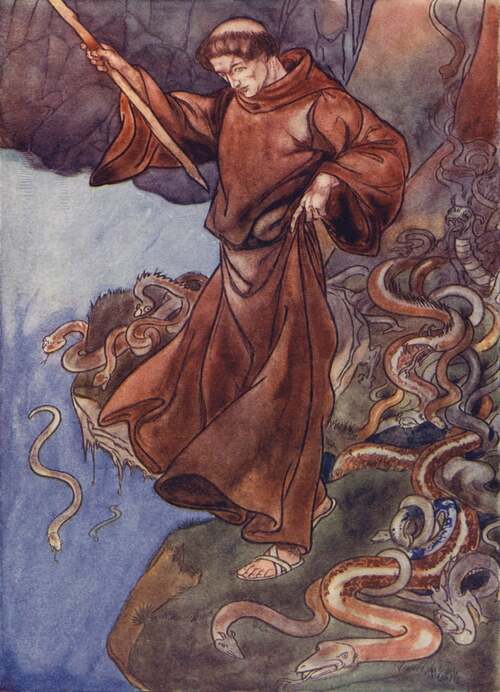
4. A well-known legend about Saint Patrick and snakes is also similar to the one with Moses in a leading role. While he was fasting on the mountain many snakes attacked him but he chased them into the sea and from then on Ireland was free of snakes. Scientists never managed to find any traces of snakes in the history of Ireland so St. Patrick should not be credited for that. Anyway, the legend is very likely based on the story about Moses and Aaron who transformed their staffs into snakes which ate the snakes sent by the pharaoh's sorcerers.
5. Patrick's attempt to convert Irish pagans to Christians was not easy. It was actually very dangerous on several occasions. Once, for instance, he and his followers were about to be attacked by Druids but St. Patrick noticed the danger right in time to transform his group into deers which elegantly escaped from angry pagans.
6. Another encounter with Druids happened at the yearly festival held by pagans all over Ireland. Druids had a tradition to lit a huge fire at the Hill of Slane and use this fire to light all other fires connected to the festival. But Patrick overtook them and lit his own fire before the pagan ceremony started. Druids tried to put out his fire and lit their own. They had no success and it is said that the High King for these reasons started believing that Patrick's magic (Christianity) was more powerful than the magic of Druids (paganism). This eventually led to the conversion of many noblemen and women in Ireland.
7. Even a more famous legend could bear more truth than others. While Patrick tried to explain the concept of the Trinity to Celtic pagans, he used his knowledge about their deepest beliefs where number three had an extremely powerful impact. He took a shamrock, today a national plant of Ireland, to show them the simple example of the Trinity - three leaves and one stem, representing three entities in on God. There is also speculation that the shamrock was a perfect example of natural regenerative powers that were connected with the idea of eternal life in Christianity.
8. St. Patrick wanted to build a church at the top of Ard Mhacha. The chieftain Daire gave him permission to build only at the lower ground. After that, his horses died after grazing in the area of the church. Daire believed it was St. Patrick's fault. He ordered his men to kill the saint. But then Daire himself became ill and St. Patrick was asked to help. Patrick not only managed to heal the chieftain with holy water but revived horses as well. Daire thanked Patrick by giving him a big bronze cauldron and permission to build at the top of the hill. The church at Armagh (today's name) became the head church of Ireland.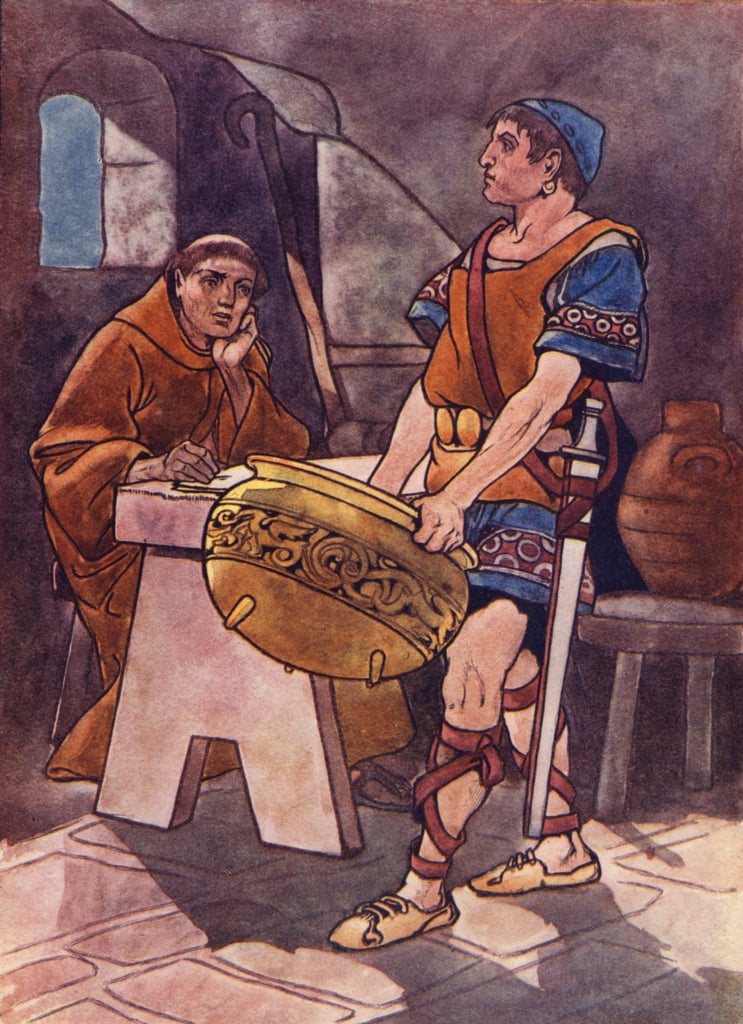
9. Patrick had a clash with another chieftain. His name was Crom. Patrick asked him for food and Crom sent him a bull expecting that the animal would attack the saint. Instead of that, the bull peacefully came to the holy man and allowed to be slaughtered. When Crom heard the bull was eaten he demanded it back. Patrick took the bones and the hide of the bull and brought it back to life. There are two endings of this legend. In one of them Crom was killed by the bull and in the other he was so impressed he converted to Christianity.
10. Patrick had his share of adventures with innkeepers too. Once he met a lady of the house who served her guests smaller portions than she should. He told her she had a demon in her cellar and this demon was gaining fat of her greed. She could get rid of the demon only by becoming honest. She listened to his advice and some time later he visited the same inn again. This time cups were filled with whisky to the brim. Patrick and the innkeeper went into the cellar where they saw a demon shrinking in pain until eventually disappeared in flames. After Patrick's suggestion, from then on whisky should be drunk on his feast day. This is how the tradition of drowning the shamrock on St. Patrick's Day started.
images credit: https://charlesrobinsonillustrator.blogspot.com/2024/01/patron-saints-of-great-britain-and-ireland.html votre commentaire
votre commentaire
-
Par mythos le 22 Mars 2020 à 22:15
John Flaxman's View on The Odyssey of Homer
First thing first: Ulysses (Roman) and Odyssey (Greek) is the same name and it is used interchangeably in this post devoted to one of the greatest epics in our history, a poem attributed to Homer, who described one's hero from the Trojan war return home no less attractive and breathtaking as the war itself.
The story is told on two main levels. The first one is a 'roadie' of Odyssey who has to fight many mythical creatures and other dangers if he wants to get home, eventually spending many years for that, making almost everybody believe he is already dead. The other is taking place right in his home, on Ithaca, where his wife Penelope and his son Telemachus try to stop Penelope's suitors who are not attracted only by her beauty but by the throne of the kingdom.
The next series of etchings present more than 30 scenes from this epic which inspired hundreds of adaptations in more than 27 (!) hundred years since it was written. Engravings are work of James Parker (1757-1805) after line drawings by John Flaxman (1755-1826). There are probably more works on the same theme because initially there was a plan for only one book with Iliad and Odyssey published together in 1805.
Later each of these monumental pieces of Western culture was published separately (in several editions and reprints), sometimes with less and sometimes with more drawings. But this selection definitely offers an accurate view of Flexman's legacy. Ironically or not, one of the most successful sculptors in the world (in his lifetime) is best remembered by his drawings, considered as just a side project.
The dimensions of originals are 259 mm x 410 mm. On-line versions can be seen here.
(The Odyssey of Homer Engraved from the Compositions of John Flexman R.A., Sculptor)
Council of Jupiter, Minerva, and Mercury
(Meantime Telemachus, the Blooming Heir of Sea Girt Ithaca Demands My Care)
The Descent of Minerva to Ithaca
(From High Olympus Prone Her Flight She Bends and in the Realm of Ithaca Descends)
Phemius Singing to the Suitors
(At Length Composed He Joined the Suitors Throng Hushd in Attention to the Warbled Song)
Penelope Surprised by the Suitors
(We Saw As Unperceived We Took Out Stand the Backward Labours of Her Faithless Hand)
Telemachus in Search of His Father
(Telemachus Already Prest the Shore: Not First ... The Power of Wisdom Marched Before)
Nestor's Sacrifice
(The King Himself Initiates to the Power)
Penelope's Dream
(Close to Her Head the Pleasing Vision Stands and Thus Performs Minerva's High Commands)
Mercury's Message to Calypso
(God of the Golden Wand: On What Behest Arrivst Thou Here, an Unexpected Guest)
Leucothea Preserving Ulysses
(All Radiant on the Raft the Goddess Stood)
Nausicaa throwing the ball
(Forth from Her Snowy Hand Nausicaa Threw the Various Ball, the Ball Erroneous Flew)
Ulysses Following The Car of Nausicaa
(With Skill the Virgin Guides the Embroidered Reign Slow Rolls the Car Before the Attending Train)
Ulysses on the Hearth Presenting Himself to Alcinous and Arete
(And Humbled in the Ashes Took his Place Silence Ensu'd)
Ulysses Weeps at the Song of Demodocus
(Concealed He Grieved the King Observed Alone)
Ulysses Giving Wine to Polyphemus
(More: Give Me More He Cried, the Boon Be Thine Whoe Er Thou Art That Bearst Celestial Wine)
The King of the Lestrigens Seizing One of the Companions of Ulysses
(One for His Food the Raging Glutton Slew)
Ulysses at the Table of Circe
(Why Sits Ulysses Silent & Apart, Some Hoard of Grief Close Harboured at His Heart)
Ulysses Terrified by the Ghosts
(But Swarms of Spectres Rose from Deepest Hell, with Bloodless Visage, and with Hideous Yell, They Scream, They Shriek: Sad Groans and Dismal Sounds Stun My Scared Ears, and Pierce Hell's Utmost Bounds)
Morning
(Here the Gay Morn Resides in Radiant Bowers, Here Keeps Her Revels with the Dancing Hours)
The Sirens
(Our Swift Approach the Siren Outre Describes Celestial Music Warbles from Their Tongue)
Scylla
(When Lo: Fierce Scylla Stoopd To Seize Her Prey, Stretched Her Dire Jaws, Swept Six Men Away)
Lampetia complaining to Apollo
(Meantime Lampetia Mounts the Aerial Way and Kindles Into Rage the God of Day)
Ulysses Asleep Laid on his own Coast by the Phaeacian Sailors
(And Gently Placed him on the Rocky Shore)
Ulysses Conversing with Eumaeus
(Enough of Woes Already Have I Known)
Apollo and Diana Discharging their Arrows
(They Bend the Silver Bow with Tender Skill and Void of Pain the Silent Arrows Kill)
Minerva Restoring Ulysses to his own Shape
(She Said & Oer Him Waves Her Wand of Gold)
Ulysses and his Dog
(Takes a Last Look & Having Seen Him Dies So closed for Ever Faithful Argu's Eyes)
Ulysses Preparing to Fight with Irus
(Then Pale with Fears & Sickening with the Sight They Draggd The Unwilling Irus to the Fight)
Euryclea Discovers Ulysses
(Deep Oe'r His Knee Inseamed Remained the Scar: Which Noted Token of the Woodland War When Euryclea Found The Ablution Ceased)
The Harpies Going to Seize the Daughters of Pandaras
(Winged Harpies Snatched The Unguarded Charge Away)
Penelope Carrying the Bow of Ulysses to the Suitors
(To the Proud Suitors Bears in Pensive State the Unbended Bow and Arrows Winged with Fate)
Ulysses Killing the Suitors
(Haste & Return Ulysses Made Reply While Yet the Auxillar Shafts This Hand Supply)
The Meeting of Ulysses and Penelope
(At Length Recovering to His Arms She Flew)
Mercury Conducting the Souls of the Suitors to the Infernal Regions
(Cyllenius Now to Pluto's Dreary Reign Convey's the Dead, a Lamentale Train)
Ulysses Departing from Lacedaemon for Ithaca
(Ulysses Departing from Lacedaemon for Itaca, with His Bride Penelope, Her Father Icarius Followed the Car Intreating His Daughter Not to Leave Him, Ulysses Offered Her the Choice of Returning with Her Father or Going with Him, She Answered Nothing But Covered Her Face with Her Veil)
Published by Longman, Hurst, Rees & Orme, Paternoster Row, R.H. Evans, Pall Mall, W. Miller, London, 1805.
 votre commentaire
votre commentaire
-
Par mythos le 14 Avril 2019 à 21:14
Persephone is a very important character in Greek mythology. Not only by her position or magical powers but for the story about her abduction, which clearly presents the relationships among the Greek gods as well. There are twelve major deities on Greek Pantheon and Persephone is a daughter of two: Zeus and Demeter. Functions of Demeter and Persephone often overlap, depending on the location of their worshippers, so it's probably best to focus on the central story about the Persephone's abduction where Demeter actually plays the more important role. This way we'll at least understand how important they both are.
Demeter is a goddess of nature, agriculture, but also inevitably deeply involved in the recurring cycle of birth and death in nature. In Roman mythology, she is called Ceres. She was also a central figure in Cretan cult built around opium made from poppies. Her brother Zeus raped her and Persephone was born.
Persephone (Proserpina in Roman mythology) was a beautiful girl. Wherever she landed her foot, flowers appeared and animals followed her to admire her beauty. She soon caught the eye of Hades, her uncle, and god of the underworld. Demeter noticed that and made clear the marriage of her daughter with Hades is out o the question. But Hades knew who can help him - who else than Zeus, the greatest master of abductions and rapes ever.
So one day when Persephone picked flowers with Oceanids, water nymphs, who kept her company. Aphrodite, Artemis, and Athena were also there. Suddenly the most beautiful narcissus caught the attention of Persephone. She moved a few steps from the group and while everybody looked in another way, she tried to pick the flower. The Earth opened and from the rift, a black chariot driven by Hades came. He grabbed Persephone and drove her in his kingdom under the ground.Nobody really knew what happened. One moment Persephone was there, among others, and in the next moment, she disappeared. When Demeter found out her daughter is gone, she unsuccessfully tried to find Persephone. Hekate told her she heard Persephone's cries but didn't see what happened. But Helios should see - he is the god of the sun, looking everywhere on earth after all. So Helios told Demeter about the deal between Zeus and Hades. He also mentioned Persephone got a pretty good match - one of the most powerful deities of all.
Demeter was enraged. Soon after she became depressed. She was wandering around the world without doing her job - taking care of the grains - and feminine struck out. People started to die massively. Zeus wasn't happy with that. They were his worshippers! Unfortunately, nobody else could do her job, so he had to do something about her sorrow.Zeus sent Hermes, the divine messenger to Hades. Hades must return Persephone. While Zeus was technically his king and his commands should be obeyed, Hades had a plan on his own. Zeus was his younger brother after all. Yes, Persephone can return home on one condition: if she didn't eat any food from the underworld. Of course, he gave her some pomegranates to eat before that ...
So Persephone happily returned to her mother who immediately brought life on earth. Grains grew, trees bore fruit, people and animals had food again, but ... Well, Persephone couldn't stay for good. After a while, she had to return to the underground kingdom ruled by Hades.Different versions of the stories offer different reasons for her return. Some claim she became fond of her abductor, the mighty king of the dead, and missed him just like she missed life in the world of living creatures. Some stay faithful to the magic of pomegranate seeds - varying from one to six - which she ate when kidnapped.
There are also different time intervals of her life on and under the surface of the world. In some cases she has to stay under just three, in some up to six months, depending on the climate of the area where the story is told. More southern countries are happy with three, more northern need six. Why? Well, it matches with the time of winter. While Persephone resides with her husband, Demeter mourns her faith and everything on the surface dies.This means we have the cycles of summers and winters, life and death, harvest and famine, depending on the position of Persephone and the mood of her mother. If you recognized the plot from Little Red Riding Hood with Persephone in the title role and Big Bad Wolf played by the Hades, you are probably right. The mythological explanation of this fairy tale is pretty faithful to natural cycles to summer and winter, day and night, life and death, light and darkness, ... And we have a scene of careless picking flowers too!
Persephone is often portrayed with red hair - red is not only very photogenic, but can be seen as the color of sin. Her red hair is certainly easily transformed into a red hood!
Resources:
 votre commentaire
votre commentaire Suivre le flux RSS des articles de cette rubrique
Suivre le flux RSS des articles de cette rubrique Suivre le flux RSS des commentaires de cette rubrique
Suivre le flux RSS des commentaires de cette rubrique





